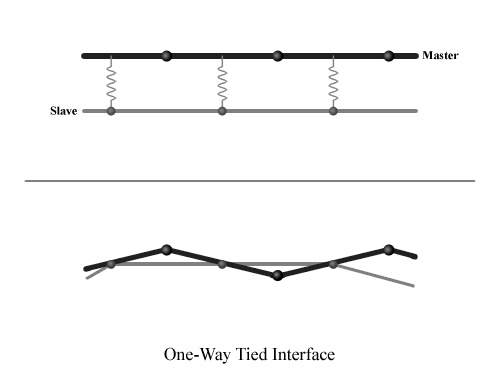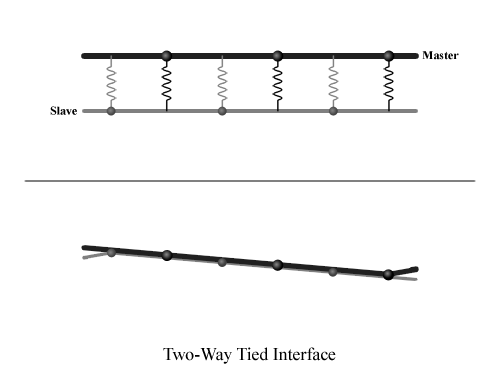This post will give you a brief summary of one-way and two-way contact definitions. The one-way/two-way refers to the treatment of slave nodes impacting the master segments.
One-Way Contacts
One-way was one of the first implementations in contact treatment and was done so such that it is computationally efficient. In the one-way contact treatment, the slave nodes are represented by discrete points with no physical connectivity between the nodes. The master is however defined is represented by segments (either 3 or 4-noded). In one-way, only the slave side is checked for penetration against the master segments. Since the master nodes do not undergo any checking, it may be possible that it could penetrate the segments or elements on the slave with no application of contact forces to prevent the penetration. Consequently, users are encouraged to define the “finer� mesh as the slave side and the coarser mesh as the master side to reduce the possibility of master node penetrating the slave side. Following figure shows the condition of contact involving a coarse-slave against a finer-master and a fine-slave against a coarse-master to illustrate the need for the slave side to be finer for better contact penetration detection in one-way contacts. Due to the nature of the one-way treatment, the resulting contact-impact is dependent on slave/master definition. Switching slave and the master sets, could result in different behavior depending on the geometry and the mesh sizes. Examples of one-way type contact definitions are all contacts with either NODES or ONE_WAY string present in the contact keyword. A complete list of one-way contacts are listed here.
- CONTACT_NODES_TO_SURFACE
- CONTACT_AUTOMATIC_NODES_TO_SURFACE
- CONTACT_ONE_WAY_SURFACE_TO_SURFACE
- CONTACT_ONE_WAY_AUTOMATIC_SURFACE_TO_SURFACE
- CONTACT_FORMING_NODES_TO_SURFACE
- CONTACT_FORMING_ONE_WAY_SURFACE_TO_SURFACE
- CONTACT_CONSTRAINT_NODES_TO_SURFACE
- CONTACT_ERODING_NODES_TO_SURFACE
- CONTACT_RIGID_NODES_RIGID_BODY
- CONTACT_RIGID_BODY_ONE_WAY_TO_RIGID_BODY
Two- Way Contacts
Two-way contact treatment is identical to the one-way except that the penetration detection is symmetric. This requires that both slave and master definitions have connectivity information and can only be defined as either part or segments. In two-way contacts, first the slave nodes are checked for penetration against the master segments after which the nodes of the master segments are checked for possible penetration against the slave segments. This dual treatment eliminates the need for the user to carefully choose the slave and the master side since switching the slave/master will result in identical behavior. Two-way contact definitions are highly recommended unless the slave side is much finer that the master. All contact keywords with the string “SURFACE_TO_SURFACE� without “ONE_WAY� or having the string “TWO_WAY� are examples of two-way contact definitions. Below is list of two-way contact definitions available in LS-DYNA.
- CONTACT_SURFACE_TO_SURFACE
- CONTACT_TWO_WAY_NODES_TO_SURFACE
- CONTACT_AUTOMATIC_TWO_WAY_NODES_TO_SURFACE
- CONTACT_AUTOMATIC_SURFACE_TO_SURFACE
- CONTACT_FORMING_SURFACE_TO_SURFACE
- CONTACT_FORMING_TWO_WAY_NODES_TO_SURFACE
- CONTACT_CONSTRAINT_SURFACE_TO_SURFACE
- CONTACT_ERODING_SURFACE_TO_SURFACE
- CONTACT_RIGID_BODY_TWO_WAY_TO_RIGID_BODY
Tied Contacts
The terms one-way/two-ways also refers to all tied contacts and affects which nodes are selected for tying. In the case of tied contact definitions with the string “NODES�, only the slave nodes are processed to determine the closest master segments and if a master segment is found and meets certain criteria such as the projected distance is within certain “tolerance�, then the slave node is tied to the mater segment. In the case of two-way tied contacts, determined by the presence of the string “SURFACE_TO_SURFACE�, both the slave nodes and the master nodes are processed to determine “potential� segments to which the node can be tied. Like mentioned earlier, unless a slave side is much finer than the master, it is always recommended to use the two-way tied contact definitions to remove the dependence on the mesh disparity and also to ensure the two-surfaces (slave and master) are completely tied.
















